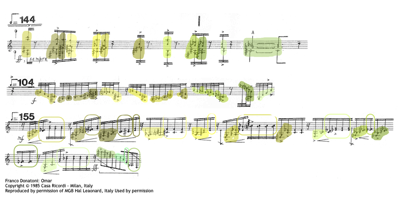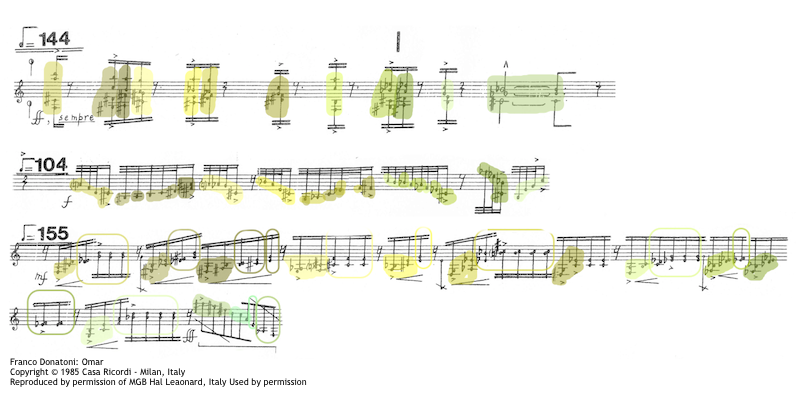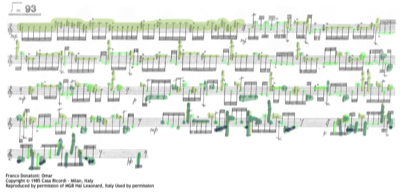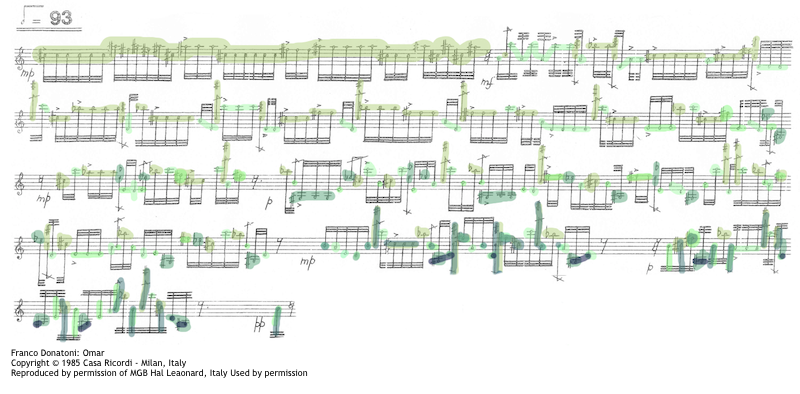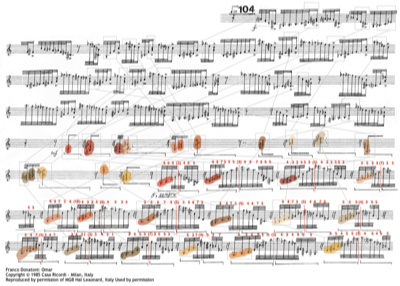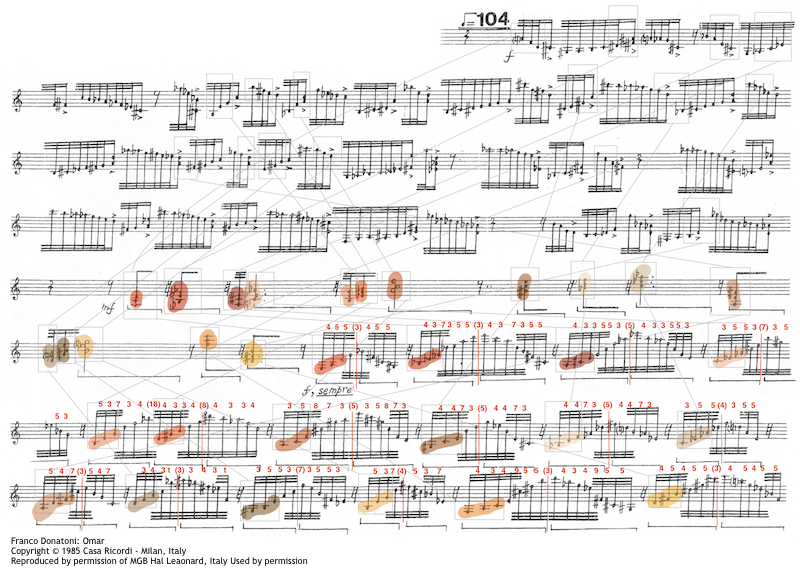Improving the practice and performance of contemporary music
The basic material is presented in the opening section marked by tempo 144. This section consists of a succession of accentuated chords, followed by non-accentuated extensions of those chords. Every succession concludes with a chord that has a marcato accent and that is significantly longer. Each marcato chord is followed by a quarter note rest. The non-accentuated extensions continue the accentuated chords logically: every following note in those chords is in fact the next available note on the keyboard in each of the four voices. The movement is centripetal: both upper voices move downwards; the lower voices move upwards.
The duration of the marcato-chords equals the number of chords that precede this marcato-chord. For example, the first succession contains 11 chords. The following marcato-chord therefore counts 11 sixteenth notes in duration. There is one exception on this filter in the opening section: the second series of accentuated and non-accentuated chords. The duration of the marcato-chord at the end of this succession equals only the second half of the series. The composer has omitted for structural reasons another marcato-accent in the middle of this succession. The very first chord of the piece contains a filter that displays the name of the composer: FrAnC(#)o, Donatoni: F-C#-A-D.
The series of accentuated and non-accentuated chords and the marcato-chords from the opening section form the basic material and are subject to processing via filters and panels throughout the whole composition. They can also appear in a combined way.
Opening Chords and development: T° 144, T° 104 and T° 155
The chords of the first section - without the marcato chords - are subject to the first process: The filter that is used within both leads to a melodic approach of the material. The grouping of the notes as they were presented in the chords remains the same, but the voicing and order of the notes change. In the next section, specified with tempo 155, Donatoni applies a new filter. The voicing is changed again: every chord is split up into dyads. After the presentation of each chord, the basic material is mirrored literally around the top note of the second dyad. All the chords from the opening section are treated similarly throughout this section.
The marcato-chords, which were not part of the preceding section with tempo 104, are now conserved through tempo 155. These chords form the beginning of every interjected descending arpeggio. The next three notes of the arpeggio are an extension of each of those chords. The last notes of every arpeggio emerge through a filter that mirrors the former intervals. The example shows how these filters are applied to the first series of chords until the first marcato chord:
- The first chord from the preceding part becomes the first four notes of the pattern
- The second and third chord form together the second pattern
- The fourth chord forms the third pattern
- The fifth chord builds the first pattern after the rest
- The sixth and seventh form the second pattern
- The eight and tenth chord form the third pattern
- The ninth chord equals the first pattern after the eighth rest
- The eleventh chord builds the second pattern.
- The rests in between the different parts are augmented: from 1-sixteenth rest to 6-sixteenth rests
The next section shows how the cords are used in dyads and mirrored around the top note.
When performing the opening part in T° 144, the muscle feeling should be rather stiff, since the chords constitute a series where the intervals stay partly the same. It’s good to “block” the muscles in the arms for this part. By doing this, the sound will also get stiffer and denser, which will make the whole thing more rigid. Make sure there is enough difference between non-accentuated, accentuated, and marcato chords. Also try to play all the top notes of every chord in the middle of the bar and to make the voicing of the chords sound natural. This will add a lot to the feeling of an organic sound throughout the piece.
In the next part, with T° 104, the feeling can be more “melodic” and fluid. The muscle feeling here should be thick and flexible, with everything as relaxed as possible. When playing the section in T° 155, the muscle feeling can be rather stiff again. The overall musical idea can be very vertical and block-like. For the small intervals like minor seconds, it is best to play at the very edge of the bar, so you don’t have to incline your hand too much. This will increase speed and accuracy. For the downward arpeggios, practicing them both downwards and back upwards will enhance the muscle memory in the fingers and arms. For the whole passage, make sure all dynamics are treated identically; this is also valid for the accents and the crescendi. This is crucial to display the inner structure of the piece.
Return to opening material: T° 93
In the section with tempo 93, material from the marcato-accents in the opening section is subjected to a new filter. An increasingly capricious melody is constructed by adding one note at a time. The sequence starts with the notes c#-f#-a#. Those are the notes out of the first marcato chord in tempo 144. After this, the notes out of the second marcato chord are filtered in: a-c-d, et cetera. Only the f natural that appears in the last double accentuated chord is not used in this sequence. These additions go on until the first appearance of the B4 as shown in the example. The result is a harmonic-melodic envelope that is based on the material from the marcato-chords. The rests separating the different phrases are augmented each time: from 1 to 11 32nd note length. Donatoni filters out more and more notes toward the end by adding pauses into the material. The inserted B4 is subjected to a gradual crescendo, while the rest of the material undergoes a diminuendo until the end of part I of Omar. By using these processes, the density of the phrase diminishes, until at the end only the frame of the music stands.
This part is a very light, fast and delicate part. A suggestion is to “over-tense” both arm and finger muscles for this part, so the energy level is very high. At the same time, the lightness can be obtained by playing each and every note as an up-stroke. This way of practicing means using a lot more energy and practise time, but the result will be much more satisfactory.
Triads and mirrors: T° 104
In order to obtain triads, Donatoni uses a new filter on the melodic series that appears in the section with tempo 104 in the first part of Omar. He filters out every series of consecutive notes that form a traditional triad and writes them as a chord. After introducing the triads, this material is further extended. Again, the triads are the subject of an ascending melodic approach. The resulting succession of intervals are extended and mirrored downwards.
Just as in the first part of this section, the section with triad chords should be played with a flexible muscle feeling and as relaxed as possible. Make sure the pedal is used in a clean way, bringing out only the notes and rhythms that should be brought out. For the third part with the upward and downward arpeggios, make sure no notes remain sounding after the juxtaposed pedals.
